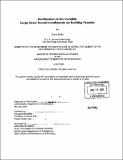| dc.contributor.advisor | Krzysztof Wodiczko. | en_US |
| dc.contributor.author | Bodle, Carrie | en_US |
| dc.contributor.other | Massachusetts Institute of Technology. Dept. of Architecture. | en_US |
| dc.date.accessioned | 2006-06-19T17:33:33Z | |
| dc.date.available | 2006-06-19T17:33:33Z | |
| dc.date.copyright | 2005 | en_US |
| dc.date.issued | 2005 | en_US |
| dc.identifier.uri | http://hdl.handle.net/1721.1/33025 | |
| dc.description | Thesis (S.M.)--Massachusetts Institute of Technology, Dept. of Architecture, 2005. | en_US |
| dc.description | Includes bibliographical references (p. 58). | en_US |
| dc.description.abstract | The intention of this project is to utilize sound as representation of MIT research-extending out to the public what may be invisible, or less known to the broader community interested in MIT's spectrum of work. I am utilizing Building 54, also known as the Green Building, on the MIT campus to address the public and MIT community through a vehicle of transmission utilizing sound as representation of research here at MIT. Collaborating with scientists from MIT's Haystack Observatory, I am proposing the sonic display of research data from an architectural scale, a speaker setup on the south facade of the Green Building. This project will be a multi-speaker sound installment with a total of 35 Public Address speakers temporarily attached to the vertical concrete columns on the buildings' facade. The speakers will be broadcasting audio representations of sound waves embedded in Earth's charged upper atmosphere, or ionosphere. These sounds make tangible the state of the ionospheric portion of the terrestrial upper atmosphere, a region under active radar study by the Atmospheric Sciences Group at MIT's Haystack Observatory. The speaker arrangement on the Green Building's facade visually reminds the listener of an upwards-sloping graph. This is representative of the spectral frequency distribution of the sounds, which vary both by time and in altitude. | en_US |
| dc.description.abstract | (Cont.) This large-scale sound installment will make tangible the converging perspectives of contemporary arts and upper atmospheric science, representative for the advanced research focus of this institution, and exemplary for MIT's interests in creating an environment in which the arts merge with technology to create inspirations for artists and scientist likewise. The scale of this project is considerable, but so is the size of the Haystack Observatory installation, the distance to the ionosphere, and the iconic silhouette of the Green Building overseeing the MIT campus when viewed from the Boston bank of the Charles River. | en_US |
| dc.description.statementofresponsibility | by Carrie Bodle. | en_US |
| dc.format.extent | 60 p. | en_US |
| dc.format.extent | 2703635 bytes | |
| dc.format.extent | 2705330 bytes | |
| dc.format.mimetype | application/pdf | |
| dc.format.mimetype | application/pdf | |
| dc.language.iso | eng | en_US |
| dc.publisher | Massachusetts Institute of Technology | en_US |
| dc.rights | M.I.T. theses are protected by copyright. They may be viewed from this source for any purpose, but reproduction or distribution in any format is prohibited without written permission. See provided URL for inquiries about permission. | en_US |
| dc.rights.uri | http://dspace.mit.edu/handle/1721.1/7582 | |
| dc.subject | Architecture. | en_US |
| dc.title | Sonification of the invisible : large scale sound installments on building facades | en_US |
| dc.type | Thesis | en_US |
| dc.description.degree | S.M. | en_US |
| dc.contributor.department | Massachusetts Institute of Technology. Department of Architecture | |
| dc.identifier.oclc | 62095665 | en_US |
